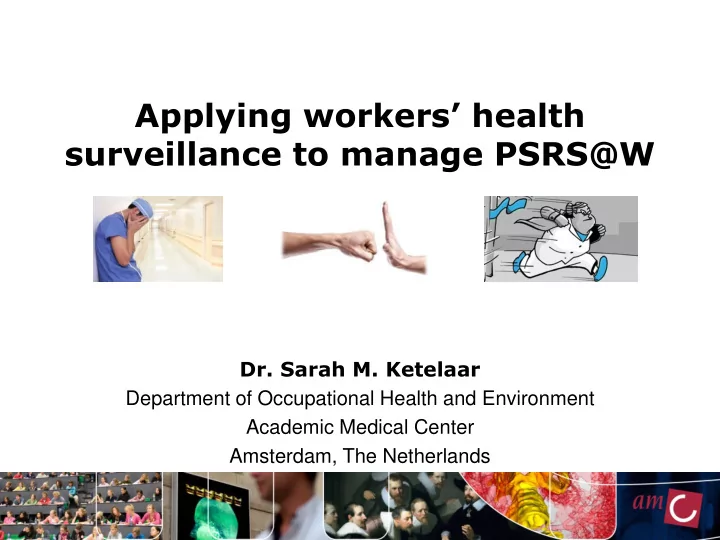

Applying workers ’ health surveillance to manage PSRS@W Dr. Sarah M. Ketelaar Department of Occupational Health and Environment Academic Medical Center Amsterdam, The Netherlands
Workers ’ health surveillance? (1) • International Labour Office: “ Workers' health surveillance should be an essential component of programmes aimed at the protection of workers .” • Dutch Working Conditions Act: “ Employers shall give employees the opportunity to undergo examinations at regular intervals with an aim to prevent or limit the risks posed to their health by their work to the greatest possible extent.”
Workers ’ health surveillance? (2) • Employees voluntarily participate in job-specific and work-related health examination • Results are discussed with employee • Employee is given advice and interventions are put into action to improve work-related health • Organisation is given advice if applicable (and individuals not identifiable) • Repeated at regular intervals Guidelines: International Labour Office: Technical and ethical guidelines for workers ’ health surveillance Netherlands Society of Occupational Medicine: Practice guideline on workers’ health surveillance (Sluiter et al. 2013)
Research findings in healthcare setting (1) • Hospital physicians: 1 – Good feasibility and acceptability of WHS – Positive effects of WHS on health, work functioning and long-term work ability perceived by 2/3 of participants 1. Ruitenburg et al 2015, Int J Occup Med Environ Health
Research findings in healthcare setting (2) • Hospital nurses and allied health professionals: – Mental module for WHS performed by occupational physician improved work functioning (cost-)effectively 1 • Return on investment € 5-11 – Mental module for WHS using e-mental health did not improve work functioning compared to control group 2 – Mental module for WHS was well-received by participants 3 1. Gärtner et al 2013, J Occup Environ Med; Noben et al 2014, Int J Nurs Stud; Noben et al 2015, Int J Occup Med Environ Health 2. Ketelaar et al 2013, PLoS ONE; Noben et al 2014, Int J Nurs Stud 3. Ketelaar et al 2013, J Occup Environ Med
WHS in practice @ AMC (1) 1. Online questionnaire on (work-related) health, personal ability to deal with job demands, work ability, work perception Regarding PSRS@W: - Exposure to and impact of agressive and/or traumatic incidents - Mental health problems - Need for recovery after work - Perceived workload - Perceived team atmosphere, contact with colleagues and supervisor
WHS in practice @ AMC (2) 2. Physical examination by doctor’s assistant: vision, hearing, blood pressure, weight, height, waist circumference 3. Appointment with occupational physician: discussing results and personal advice to improve work-related health
WHS: primarily targeted at supporting individual employees in remaining healthy and well- functioning, but… Causes for ill health at work, especially regarding psychosocial aspects, often within work environment. So: what can be done at the organisational level?
Possible organisational interventions (1) Example 1: regarding stress and high perceived work load (resident physicians) 1. Extensive survey on problems potentially leading to high perceived workload 2. Subsequent group discussions with resident physicians and educators 3. Determine action plan 4. Aspects transcending department → determine hospital-wide measures
Possible organisational interventions (2) Example 2: regarding need for recovery after work • Implementing self-rostering or offering more control over working times – Positive effect on fatigue during night shifts 1;2 – Positive effect on work/life balance 1 1. Nijp et al 2012, Scand J Work Environ Health 2. Joyce et al 2010, Cochrane Database Syst Rev
Possible organisational interventions (3) Example 3: regarding exposure to agressive and/or traumatic incidents • Policy and code of conduct? • Training in handling and de-escalating incidents? • Support and aftercare? • Systematic recording and evaluation (for preventive purposes)?
Possible organisational interventions (4) Example 4: regarding perceived team atmosphere, contact with colleagues and supervisor • Training employees in positive communication skills • Does the supervisor set a good example? • Counsellor available?
Concluding: why implement WHS? Early intervention at individual level: • Insight in personal work-related health, ability to deal with job demands, and work ability • Support to remain healthy at work by personal advice and interventions Early intervention and/or prevention at organisational level: • Insight regarding less optimal work environment • Direction towards appropriate organisational interventions Repetition at regular intervals: opportunity to monitor effectiveness of individual and organisational interventions
Recommend
More recommend